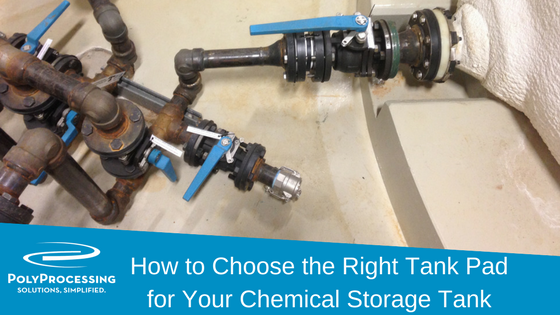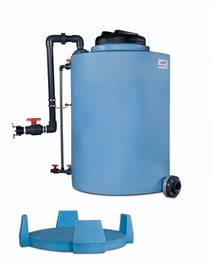How to Choose the Right Tank Pad for Your Chemical Storage Tank
A tank pad, or housekeeping pad, provides some elevation above the containment berm so that plumbing can be fitted to the bottom of a chemical storage tank. Housekeeping pads are popular with our customers, but you need to be sure you plan correctly to get the best use out of them.

Improper planning can have pricey consequences. Many times, companies come to us after pad installation because they realize they didn't think through key considerations during the planning and design phase. As a result, they make expensive alterations to accommodate their particular tank.
Avoid costly mistakes. Take a look at the tips below before installing a chemical storage tank housekeeping pad.
Does My Tank Really Need a Housekeeping Pad?

If you need to run plumbing below your tank to achieve a full drain, you will need to elevate your tank on a housekeeping pad. Otherwise, you'll need to route the plumbing underground.
One of the advantages of a tank pad is that it enables you to easily see if your tank is has liquid or moisture coming from underneath the tank. Because the tank sits above any collected rain, a leak would show on the tank pad, making it easy to distinguish between a chemical leak and rainwater.
A housekeeping pad also helps you spot the location of a leak. If a tank is sitting on a concrete foundation with no pad, it can be difficult to tell where the leak is coming from or how much it’s leaking. But if the tank is elevated on a housekeeping pad, you can more easily see what’s going on, because it separates the tank
from the containment system.
Types of Tank Pads
Poly Processing supplies rugged plastic housekeeping pads, which are popular for IMFO® tank  applications. These pads are specifically designed for IMFO® tanks, as the tank design requires the tank to be raised 4-6 inches to keep the flange off the ground.
applications. These pads are specifically designed for IMFO® tanks, as the tank design requires the tank to be raised 4-6 inches to keep the flange off the ground.
However, any tank that is professionally installed will typically use a concrete housekeeping pad, whether it’s a municipal or industrial application. Each pad should be designed to meet the needs of the specific application. For example, if a pad is being used to support an IMFO® tank, the pad will need to be notched to accommodate the flange.
Determining Your Tank Pad Needs
Every housekeeping pad needs to be custom designed before installation. We recommend that your designers involve Poly Processing early in the process so that you get the most reliable housekeeping pad for your particular application.
For example, a customer may buy a 12-foot-diameter tank and install it on a 12-foot housekeeping pad, then realize that they need seismic restraints. Our restraints are built to sit on top of the pad. If the diameter of the pad is too small, we may need to design a custom solution to accommodate the restraints, which is more expensive and riskier.
Get the Most Out of Your Housekeeping Pad
If you’re going to design a housekeeping pad for our chemical storage tanks, talk to us about it before you begin the project. We can send you information on the pad thickness, seismic calculations, and details about the best kind of concrete to use.
For specific questions about your housekeeping pad needs, contact a Poly Processing chemical storage tank expert, or check out our full product catalog.
- February 1, 2018
- Topics: Value Added
About Poly Processing
Posts By Topic
Tech Talk Podcast Episodes
Subscribe By Email
Recent Posts
- Lids for Fume-Tight Tanks: What Are My Options?
- Insulating Your Chemical Storage Tank: Why It Matters and How to Do It
- Essential Fittings and Accessories for Chemical Storage Tanks
- Choosing the Right Secondary Containment System: An In-Depth Evaluation of Your Options for Safe Storage
- The Inner Workings of Chemical Storage Tank Venting Systems
Tank Configurator

Find the recommended tank and system components for your chemical storage challenge.
Configure a Tank Package



